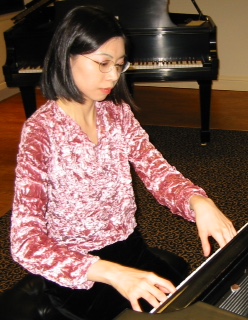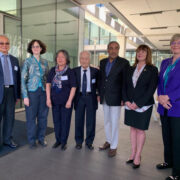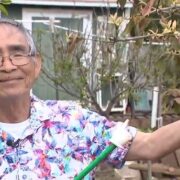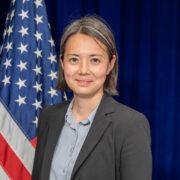I-Uen Wang Hwang 王怡雯, Painter / Composer 畫家兼作曲家
by 張理美整理
I-Uen Wang Hwang was born in Tainan, Taiwan and moved to the United States in 1994. She studied music composition at the Taiwan National Normal University (1987-1991, B.S.) and the University of Pennsylvania (1994-1998, Ph.D.). During the period of the University of Pennsylvania, she was awarded the Halstead Prize (1996, 1998) and the Nitzsche Prize (1997). She studied with George Crumb, James Primosch, Jay Reise, and Richard Wernick.
Her pieces have been performed frequently in Asia and USA. Her piece represented for Taiwan at the Asian Composer’s League Music Festivals (Malaysia 1997 and Korea 2000). As the winner of the Bohemians New York Musicians Club piano composition competition, she performed her piano composition, Dream Garden, at the New York Kosciuszko Foundation House in 2004. Taiwan Philharmonic, the National Symphony Orchestra, has commissioned and performed three of her compositions, Timeless Reflections in 2006, Lily Pond in 2008, and Diptych of Taiwan in 2010. The orchestra performed Diptych of Taiwan in Taipei, Taiwan for the premiere performance of the new Music Director, Maestro Shao-Chia Lü and in Guangzhou, China for the 2010 Canton Asian Music Festival. In 2008, the Long Duo performed her piece for two pianos, Dream Garden II, at the National Convention of the National Association of Composers in Texas and in Shanghai, China. In 2011, she was awarded a grant from the National Art and Culture Foundation of Taiwan for Watercolor Sketches, a composition for guzheng (Chinese zither), cello, and violin. A violin concerto commissioned by The Egret Cultural and Educational Foundation of Taiwan will be performed in 2014. The Carpe Diem String Quartet will premiere her String Quartet No. 2* in 2014.
Her music has been strongly influenced by painting and art since her early years because she spent much of her free time learning oil painting from her father, a professional artist. A link between her music and art thus naturally developed. In addition to composing music, she has been a watercolor artist with several exhibitions in the Philadelphia area. She helped judge the United Nations Art for Peace Contest for children in 2012. Many of her recent compositions, including the commissioned works listed above have been inspired by her own paintings. She relates the colors and textures in paintings with the harmony and timbres of her music. Musical forms also correspond to the composition and structure of her paintings. The combination of her music and painting is synergistic and clarifies her inspiration. The union of the two artistic forms also facilitates conveying her creative inspiration to the audience.
* p.s. The String Quartet No. 2 consists of two movements, which are based on two of Ms. Hwang’s watercolor paintings. The first movement, “White Light”, has a slow tempo. The music expresses the light reflecting from the petals of white lilies. In the painting, the petals consist of the untouched white of the paper, given form by the brilliant colors of the surrounding background and secondary subject matter, such as the leaves. This method of painting is known as the negative shape technique. The long sustained notes and rests in the music are analogous to the remaining white space. The long musical phases combine with subtle dynamics to depict the delicate contours of the flowers. The second movement, “Splash”, has a fast tempo. I enjoy the combined process of creating music and painting because the two art forms have similarities. Both have structure, yet at the same time require one to relax control to allow the art to speak for itself. In this movement, the splash represents the bold and free perspective that is essential for creativity.
Compiled and translated by Lii Mei B. Tsai
王怡雯生於台灣台南市. 自五歲學琴, 進入台南大成國中音樂班就讀, 高中考入台北師大附中音樂班, 而後直升保送師大音樂系. 在台期間理論作曲, 師事陳茂萱, 盧炎, 及曾興魁等老師. 鋼琴師事張晶晶, 陳惠文, 及張瑟瑟等老師. 師大畢業後曾於東吳大學擔任助教,之後在奇美文化基金會從事音樂活動. 自一九九四年赴美國賓州大學就讀. 於一九九八年得到博士學位. 在賓州大學期間連續三年得到賓大作曲獎 (Nitzsche Prize 1997, Halsted Prize 1996 & 1998). 她跟隨 George Crumb, James Primosch, Jay Reise, 及 Richard Wernick 等教授學習.
她的作品在亜洲及美國演出頻繁. 作品也代表台灣出席亜洲作曲聯盟音樂會(馬來西亜 1997, 韓國 2000); 交響曲 “秋的氣氛” 及室內樂作品 “生命之花”入選為台灣國家音樂廳成立十五週年紀念音樂會演出作品. 2004年她的鋼琴獨奏作品 “夢園” 由125首國際參賽作品脫穎而出, 獲得波西米亜音樂協會舉辦的首獎. 由她本人在紐約波蘭文化中心親自演出. 近年完成並首度在臺北演出三首台灣愛樂交響樂團與國家交響樂團委託創作的交響曲 “永恆印象” (2006); “蓮池’ (2008); “台灣雙連畫” (2010). 台灣雙連畫也再次於廣東亜洲音樂節演出. 在2008, Long Duo 雙重奏家在美國全國作曲家協會在德州舉行的年會, 演奏她的鋼琴雙重奏作品 “夢園II”. 並在上海演出. 在2011年台灣國家藝術文化基金會授與她”水彩繪畫“的頒贈, 這是為中國古箏, 大提琴和小提琴所做的曲子. 在2014年發表了為白鷺鷥文教基金會所委託創作的小提琴協奏曲, 以及為美國Capes Diem String Quartet 創作之新曲”第二號弦樂四重奏”.
她的音樂從早期就受到繪畫與藝術很強的影響, 因為她所有閒暇時間都從其職業畫家的父親學習油畫. 因此她的音樂與藝術的結合是自然發展出來的. 除了作曲之外, 她曾經在菲拉底兒飛亜地區多次展覽她的水彩畫. 在2012年她是聯合國兒童和平藝術比賽的裁判. 她近年的作曲創作, 包括上面提到的受託的作品, 很多是從繪畫激發出的靈感. 她將畫裡的顏色及紋理聯繫於音樂的和諧與性質. 音樂的型式符合她的曲子及她的油畫構造. 如此她的音樂與油畫的混合是彼此增效的而且淨晰她的靈感. 兩者的合一也促進傳達她的創作性的靈感於聽眾.
*後註: ”第二號弦樂四重奏”有兩個樂章. 是基於王怡雯自己的兩張水彩畫. 第一樂章”白光”有很慢的節奏. 音樂表達從白色百合花的花辮反射出來的光. 在繪畫上, 花辮是筆沒觸到的白紙, 它周圍亮麗的顏色及次要的東西, 例如葉子, 襯托出白光來. 這繪畫技巧稱為負面構形技術. 這音樂中很長的延長音符與休止符是比喻白空間; 很長的音句結合微妙的音律是在描繪花的細膩輪廓. 第二樂章”飛濺”有很快的節奏. 她很喜歡合併創作音樂和繪畫, 因為兩種藝術型式有相似性, 兩種都有構造而同時必須鬆弛其中的控制來讓藝術本身表達. 這樂章”飛濺”代表大膽和自由的展望, 這是創作的精粹.






